
- Mar 15, 2024
- 14 min read
Key Factors for Choosing Your Project's Tech Stack
On Startups
Custom Software Development

Vitalii Samofal
CTO
Choosing the tech stack for your project can feel overwhelming. There are dozens of popular programming languages. Each of them has specific frameworks and libraries. Plus, there are multiple cloud providers, DevOps tools, security protocols and so much more.
To help you navigate popular software development technologies, our team prepared this article. This is your ultimate guide to choosing the best tech stack for your project.
How to Choose the Right Tech Stack for Your Project
Let’s discuss what steps one should take to choose the right technological stack:
Step 1: Defining the Platform
What kind of app are you making? It could be a web-based app, a mobile app or a desktop app. If it is a mobile app, do you need an Android version, an iOS version or both? We won’t cover desktop tech in this article. If this is what you need, contact us for a free consultation.
Also, consider whether your software needs an IoT integration. This is necessary to control different devices. For example, a fitness app might benefit from an integration with smartwatches.
Step 2: Consider Project Scope
How large is your project? For example, an app for pre-ordering pastry at a local bakery could be a small project. An on-demand delivery app can be a mid-sized project. Software for a mobile network operator would be a large project.
Consider whether you are building an MVP or a full-feature app. An MVP is a Minimum Viable Product. It only has the basic features. It is good if you need a proof of concept. An MVP can also help you attract investors and raise funds.
Step 3: Scalability Requirements
Scalability can mean several different things. First, there is functional scalability. This is the ability to add more features to meet growing business needs. There is also processing scalability. This is the capacity of a system to handle more clients and data. Consider both aspects before making a tech stack choice.
Step 4: Time-to-market and project costs
With some technologies, developing software can take longer. But these technologies have merits, like stability or scalability. Consider whether time-to-market is significant for you.
Project cost is another thing to think about. Do you have a certain budget cap? How important is it for you to stay on budget?
Step 5: Maintenance requirements
All software requires regular maintenance and updates. The world of tech changes frequently. So, without updates software might become irrelevant or unsafe.
Step 6: Considering tech stack options
Now that you know your priorities and main requirements, it’s time to compare options. Our article will guide you through this process. We will discuss the most popular technologies for web and mobile apps. You will be able to compare their pros and cons.
Step 7: Interview potential developers
When you identify a potential project stack, talk to software-developing agencies. Interview various contractors. Don’t forget to find out company’s tech stack experience and industry knowledge.
Website / Web App Tech Stack
Web apps are very popular nowadays. Clients often ask us how to choose a tech stack for web development. So let’s dive into this.
Difference between the Front End vs the Back End
A web app consists of two fundamental parts – the front end and the back end.
The front end is the part of the software that you see and can interact with. It is the interface with all its elements – navigation menus, buttons, text fields, icons, etc.
The back end is the other part of an app. The back end handles business logic and data management.
So, a web development tech stack includes technologies for front and back ends.
The Front-End Tech Stack
A typical frontend technology stack includes JavaScript, HTML and CSS. Sometimes developers use TypeScript instead of JavaScript.
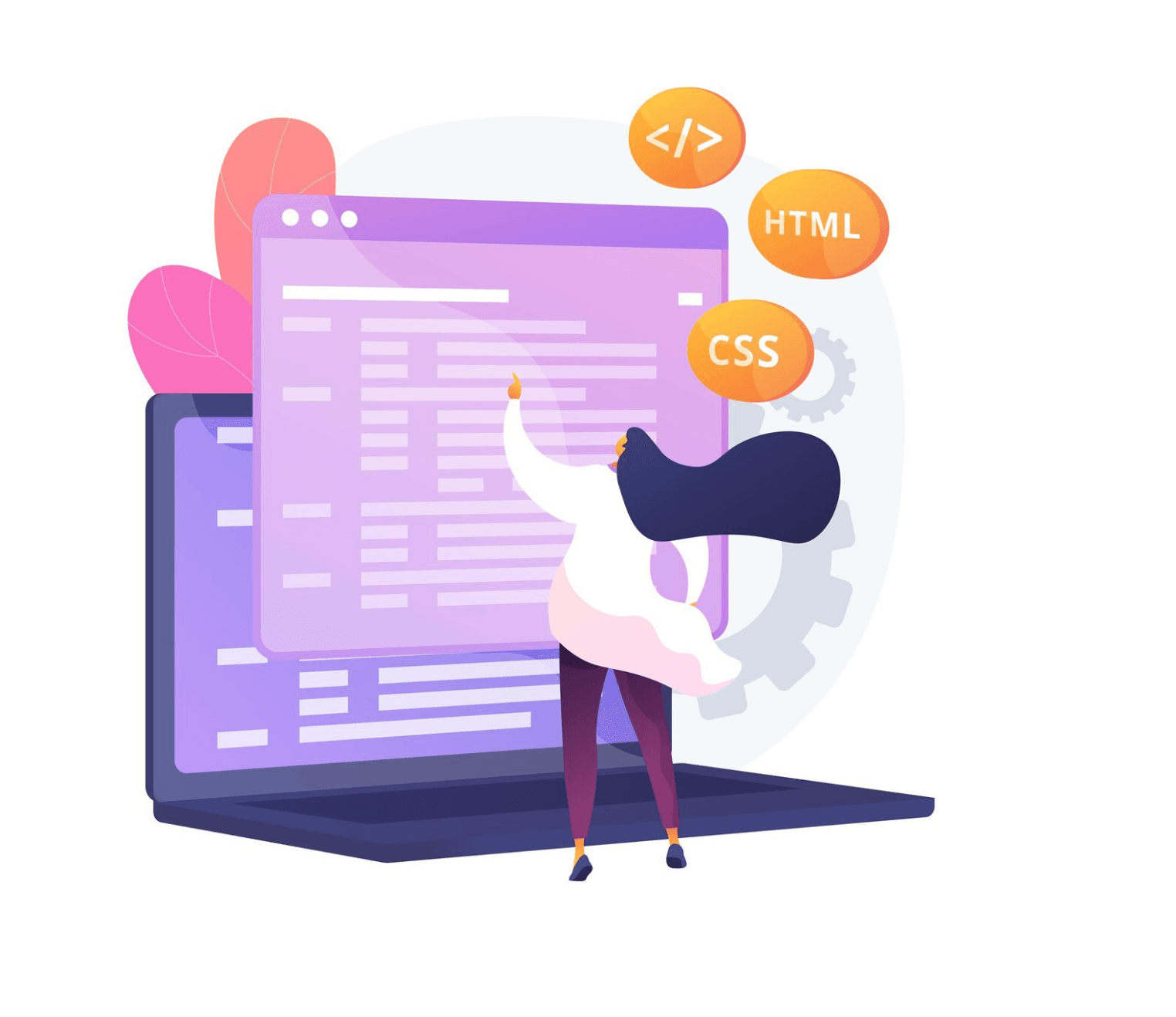
Javascript (JS) and Typescript (TS) are programming languages. They are very similar. You can view Typescript as an extension of Javascript. It brings many useful elements, but any Typescript developer also knows JS.
HTML is a markup language. It defines the structure and formatting of a text. Front-end developers use HTML to indicate headlines, lists and other elements. CSS is a useful supporting tool. It allows coders to choose text font, size, background color, etc.
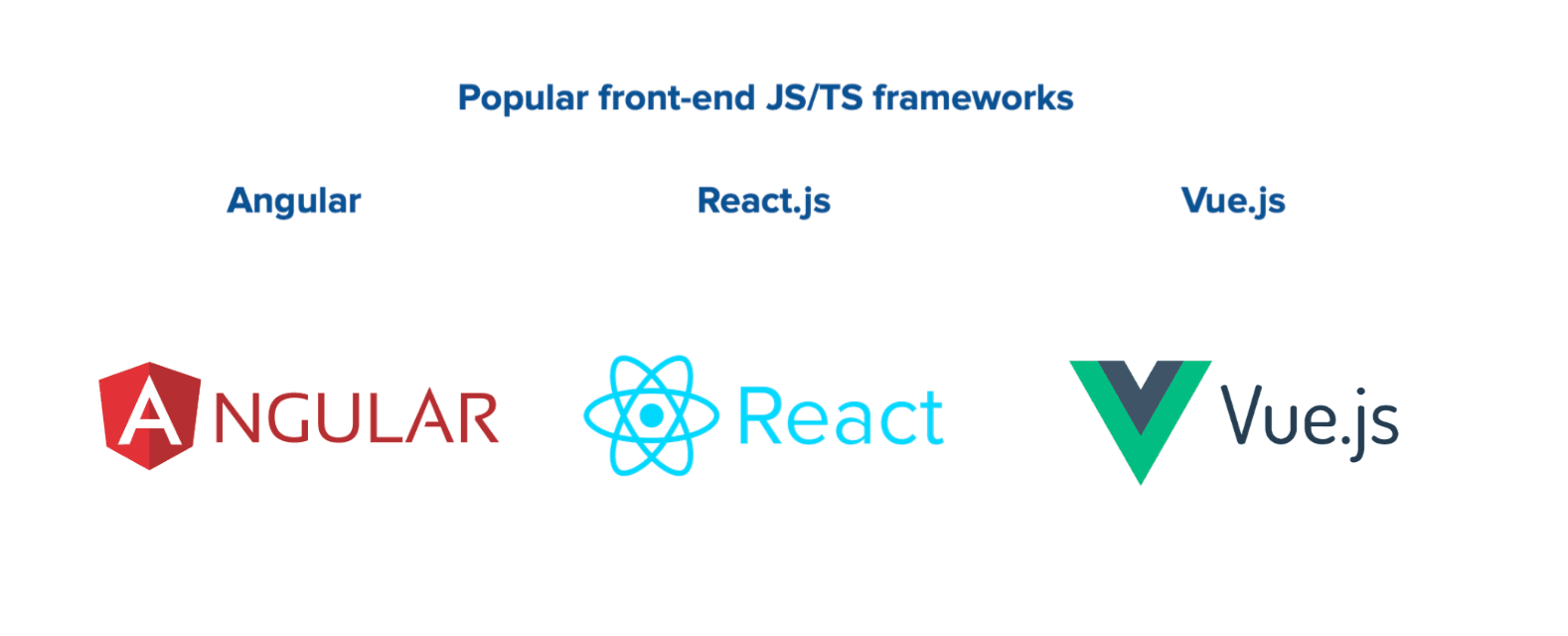
The most popular front-end frameworks are Angular, React.js and Vue.js. Angular is usually used with Typescript, while React and Vue – with JavaScript. But, as mentioned, these languages are similar. So, all three frameworks support both languages.
The Back-End Tech Stack
The back end can be created using a wide variety of technologies. Let us compare popular programming languages for back-end development:
JavaScript and Typescript: cost-efficiency, fast development
Frameworks and tools: Express.js, Nest.js, Fastify.js, Node.js, etc.
JavaScript and TypeScript are widely used for back-end development. The biggest draw is that you can use the same language for the front and back end. So, if you have a small project and time isn’t a concern, you can hire one coder for full-stack app development. This can be cheaper than hiring a team.
JavaScript and Typescript have good performance. They are also suitable for microservice architecture. Microservice architecture is popular for SaaS apps due to its scalability, flexibility and resilience.
There are many tools and technologies for JS/TS that speed up back-end development. Thus, coders often use the Node.js runtime environment. It allows coders to run the JS/TS code on a server instead of a browser. Popular JS/TS back-end frameworks include Express.js, Nest.js and Fastify.js.
Express.js provides useful features for projects of all types and sizes. Nest.js is great because it promotes a clear structure of the code. Fastify.js brings speed and efficiency. It is perfect for apps with high traffic. Developers often combine the capacities of several frameworks when working on a project.
Python: excellent time-to-market, great for AI, ML and Big Data projects
Frameworks and tools: Django, Flask, Pyramid, etc.
Python is popular for back-end development. Many Python tools make the language work great with advanced technologies, including:
– Artificial Intelligence (AI),
– Machine Learning (ML),
– Big Data,
– Internet of Things (IoT) and
– Data Science.
If your project includes any of these, you should consider Python. That being said, Java and C# also work great with such tech. Python is also an excellent choice for creating microservices.
Python’s backend tech stack often includes Django, Flask and Pyramid frameworks. Django makes projects highly scalable and speeds up development. Flusk is lightweight and flexible. It is best for small projects and apps with robust customization options. Pyramid works well for projects of all sizes. It strikes the balance between the flexibility of Flask and the structure-focused approach of Django.
Java: fast and scalable, perfect for large projects
Frameworks and tools: Spring, Hibernate, Jakarta EE, Micronaut, etc.
Java is one of the best languages for back-end dev. It’s efficient, fast, reliable, and highly scalable. Java developers value the wide variety of tools that streamline feature development. From strict security to AI – Java can handle anything you need.
The Spring framework is the most widely used. It includes the foundational toolkit, plus over 20 extensions that provide additional functionality, such as:
– Spring Boot,
– Spring Data,
– Spring Cloud,
– Spring Security,
– Spring AI, etc.
Java developers also frequently use Jakarta EE and Micronaut frameworks. The former provides scalability and reliability. It is well-suited for large and complex apps. The latter is fast, scalable and efficient. It is good for high-traffic apps and microservices. Hibernate is another useful Java tool. It simplifies the interaction between Java apps and relational databases.
C#: fast and scalable, great integration with Microsoft products
Frameworks and tools: .NET, ASP.NET, NUnit, ADO.NET, etc.
C# was developed by Microsoft. Similarly to Java, apps written in C# are easy to scale and update. It can be slightly faster than Java and the code is more readable. But it doesn’t have as many useful tools and frameworks as Java. So it’s versatile. Also, Microsoft promotes the use of Azure cloud computing for C# products.
C# is commonly used with .NET. It’s a free and open-source ecosystem of tools for C# development. Be careful not to confuse .NET with .NET framework. NET framework is the old version of the .NET product. It only runs on Windows. New .NET is sometimes called modern .NET or .NET Core. Just like Spring in Java, .NET has many extensions. For example, ASP.NET Core helps to build web applications. NUnit is a framework for unit testing. ADO.NET helps developers work with databases.
PHP: cost-efficient development, small projects are easy to maintain
Frameworks and tools: Laravel, Symfony, CodeIgniter, Laminas, CakePHP, etc.
PHP offers good performance. It integrates very well with other technologies, especially databases. This is because the language has built-in database integration modules. PHP apps are also easy to connect to content management systems, payment gateway, and other software. Of course, developers can establish such connections using other languages too. Still, this efficiency brings down development time and costs.
There are a lot of useful frameworks, libraries and other tools that simplify PHP development. The most popular frameworks are Laravel and Symfony. Laravel is perfect for smaller projects. Another benefit is a strong focus on security. Symfony works well for larger web apps with more complex business logic. Other widely used PHP frameworks include CodeIgniter, Laminas (formerly Zend) and CakePHP.
Go: excellent performance and scalability, easy to maintain, great for microservices
Frameworks and tools: Gin-Gonic, Beego, Echo, Kit, Fiber, Iris, etc.
Golang or, simply, Go is a relatively new language. It was designed at Google and released in March 2012. It swiftly gained popularity. Now, there are a lot of frameworks and tools that make Go development easier.
The most popular Go framework is Gin-Gonic (Gin). It offers excellent performance and scalability. But, it’s best suited for smaller projects. Another widely used framework is Beego. It significantly speeds up the development of web apps and REST APIs. Beego works well for large-scale enterprise projects. It also helps to automate testing. A Go tech stack can also include Echo, Kit, Fiber and Iris frameworks.
For convenience, we created a comparison table with the mentioned languages. It includes various criteria, like performance, scalability, maintainability, etc.
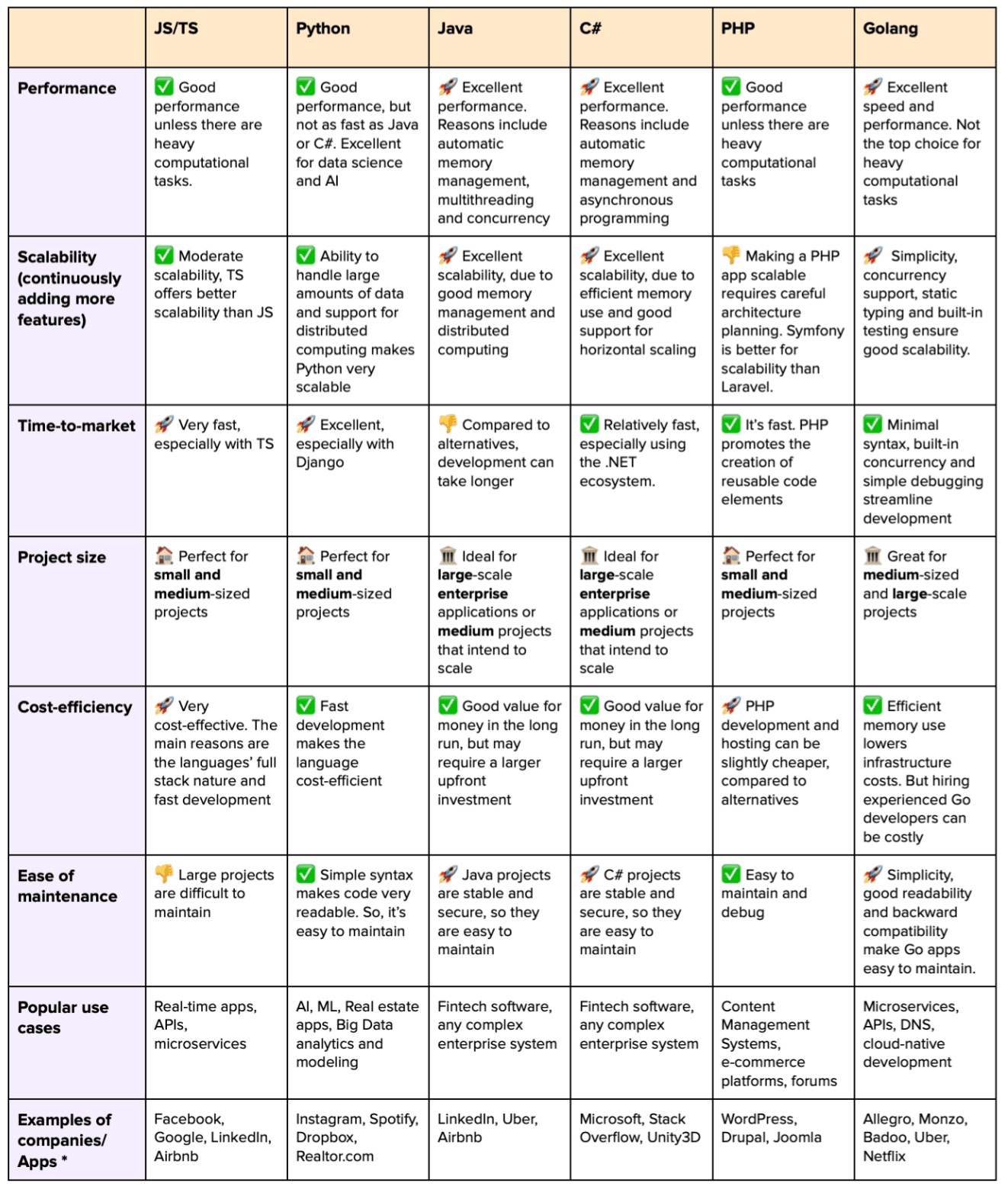
* Some companies use several languages for their back-end project stack. This is why LinkedIn and Uber appear in several columns.
If you are still unsure which language and frameworks are right for you, look at stats below. This tech stack infographic shows which frameworks are more popular than others.
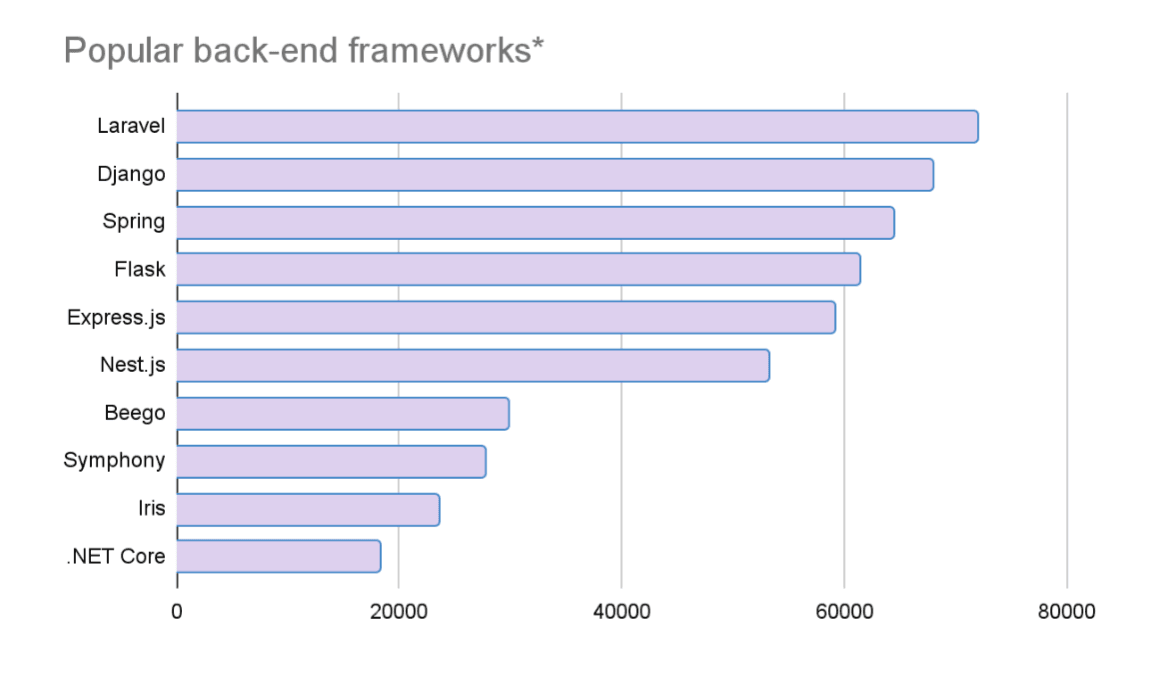
* Keep in mind that we only included frameworks based on the languages discussed above. You can visit the source page, for the full list.
Other technologies for the back-end development
Languages and frameworks are not the only considerations. Let’s briefly discuss other elements of a back-end project stack:
1. Databases
There are two types of databases: SQL (relational) and NoSQL. In relational databases, all information is organized into schemas. Schemas have tables with rows and columns. Let’s imagine we run an online shop. Our customer base is stored in a database. Each customer has certain characteristics, like an ID, a name, an email, etc.
Yet, sometimes, data isn’t homogeneous. For example, your inventory can include thousands of positions, each with unique characteristics. Thus, for T-shirts, you need to specify a size and color. Yet, for wine, size doesn’t matter. Instead, you need to state sweetness. This is when developers use NoSQL databases. Those contain small files, usually in JSON format. Each file is a database entry. In the picture below, you can see a high-level visualization of both database types.
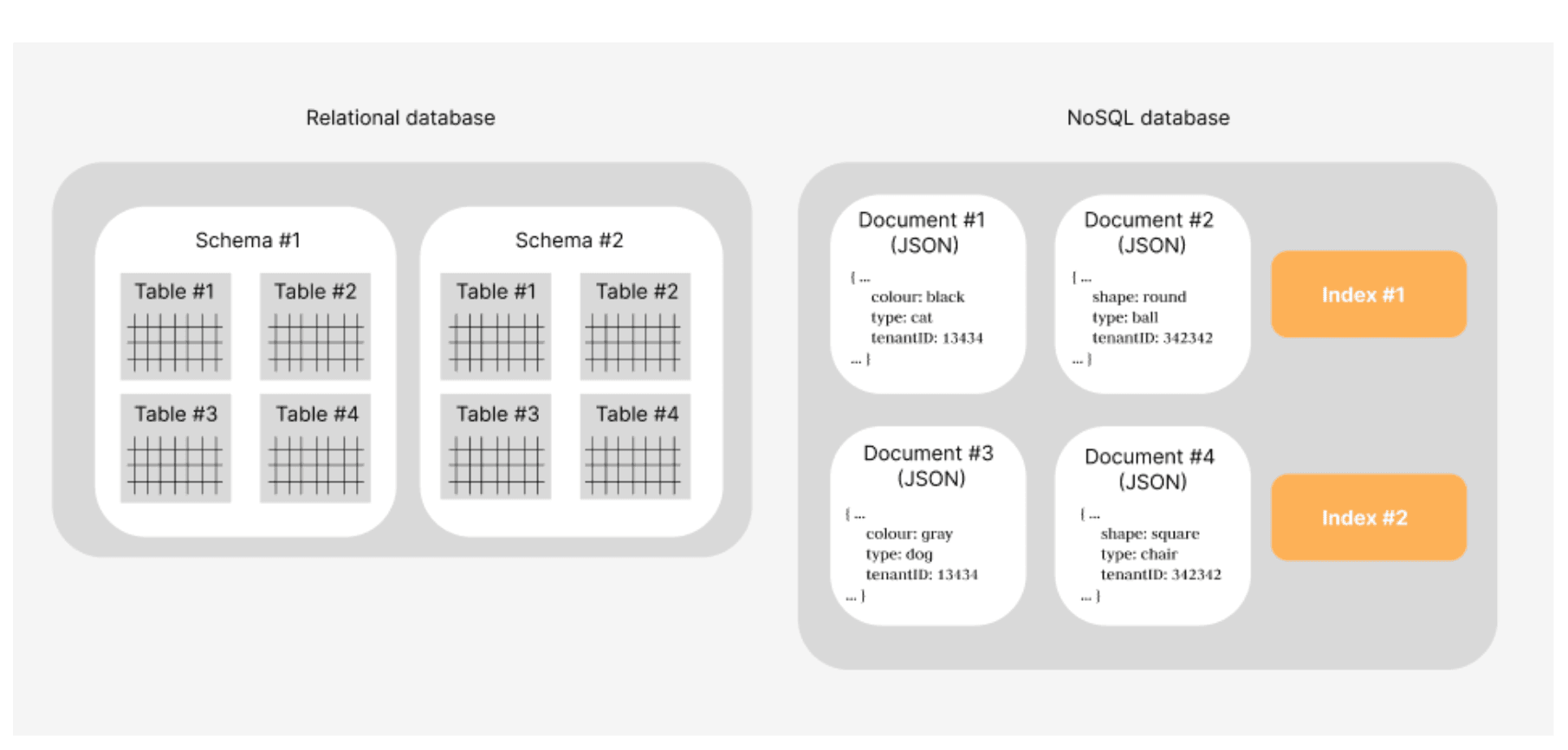
Popular SQL databases include:
– PostgreSQL
PostgreSQL is open-source. So, developers can add additional features to it if needed. It is suitable for projects of all sizes.
– Google Cloud SQL
This database is a part of Google Cloud Platform services. It has high availability and scalability. Another useful feature is automatic backups.
– Microsoft SQL Server
The database is fast, scalable and very secure. Plus, it has Business Intelligence features, a full-text search and an excellent integration with the Microsoft ecosystem.
– Amazon RDS
Amazon RDS is a part of Amazon Web Services (AWS). It is secure, scalable and provides automatic backups.
– Oracle SQL
Oracle SQL is a part of the Oracle Database system. It is especially popular among enterprise-level companies. It is reliable, scalable and secure.
– My SQL
This is an open-source database. Developers value it for its speed and reliability.
Now, let’s look at widely used NoSQL databases:
– MongoDB
MongoDB is a popular and flexible NoSQL database. It has good horizontal scalability.
– Apache Cassandra
This database boasts high availability and fault tolerance. It scales well horizontally.
– Elasticsearch
Elasticsearch is a NoSQL database plus a search engine. Its biggest benefit is the excellent full-text search functionality.
– Amazon DynamoDB
DynamoDB is an AWS service. It automatically scales based on demand. Other benefits include high availability and low-latency access.
2. Infrastructure
Decide whether to host your software on-premises or in the cloud. The most popular cloud provider is AWS (Amazon Web Services). They have 34% of the market share. The second and third largest providers are Microsoft Azure and Google Cloud. They have 21% and 11% of the market share, respectively.
There are several mid-size providers, with a 2% to 5% market share. They include IBM Cloud, Salesforce and Oracle. Examples of smaller providers Digital Ocean, Wasabi and Heroku.
The main benefits of large cloud providers are:
– Lots of services
Large cloud providers have robust ecosystems of tools. This is especially so for the top three. Their offerings include databases, AI/ML tech, IoT tools, DevOps solutions and so much more. Technologies within the same ecosystem tend to work very well together.
– Global reach and excellent scalability
Large providers have a wide international reach. So, their clients can comfortably service clients in various countries. This also ensures high availability and scalability.
– Security and useful resources
Large providers pay close attention to security. They also offer many guides and other resources to help developers use their products efficiently.
Yet, there are some downsides too:
– Complexity
A wide variety of options increases complexity. To make optimal choices, you need a good expert, specializing in a particular provider. And setting up infrastructure properly is something really worth investing in. Otherwise, you can end up wasting thousands of dollars a month.
– Costs and vendor lock-in
Even with proper setup, large cloud providers can be expensive. Moreover, if you use various proprietary features, moving to a different provider can be difficult and expensive.
Here is how the top three cloud providers compare:
Mid-sized providers, like IBM and Oracle, also offer a wide range of features. They often specialize in specific industries including healthcare, supply chain management and finance. They also have strong security and customer support. Plus, many companies use their other products. All of this helps them attract enterprise clients.
Smaller cloud providers are often cheaper and provide more flexibility. They are also easier to use and navigate. On the other hand, they have limited global reach and lower scalability.
3. DevOps and security
There are other back-end technologies to consider when building a web app. Thus, DevOps tech includes:
– Code hosting platforms (e.g. GitHub, GitLab, Bitbucket),
– Infrastructure-as-code tools (e.g. Terraform, Ansible, AWS CloudFormation),
– Containerization and orchestration solutions (e.g. Docker, Kubernetes),
– Monitoring and logging software (e.g. Prometheus, Grafana).
Popular types of security tech include:
– Code vulnerability scanners and other security testing apps (e.g. CodeScan, Veracode, Netsparker, Acunetix),
– Identity and Access Management solutions (e.g. Okta, Azure Active Directory, Google Cloud IAM).
These are not comprehensive lists. But it should give you an idea of what to look for. You can discuss these tools in detail with your potential developers.
Mobile App Tech Stack
When it comes to mobile development, you have two options. First, you can develop a single app suitable for both iOS and Android platforms. Experts call it cross-platform development. Second, you can create two separate apps for each operating system.
Let’s briefly compare both options:
As you can see, cross-platform development is, overall, a better option. It is faster and much cheaper. Plus, such apps are easier to maintain. Yet, native apps excel at performance and user experience. Consider your priorities to make the right choice.
Cross-platform mobile technological stack
The most popular frameworks for cross-platform mobile dev are:
– Flutter
Flutter uses the Dart programming language. This is a relatively new framework, but it has become very popular over the past few years. It was created by Google. Flutter allows developers to create an app quite fast. This further improves time-to-market. Flutter also has a hot reload feature. With it, developers can see the effect of code changes almost instantly.
– React Native
React Native is a JavaScript framework. It is widely popular for cross-platform mobile development.
React Native was developed by Facebook and has a large ecosystem of libraries and other useful tools. This makes development fast and cost-efficient. Plus, React Native allows one to create an interface that looks native.
– Xamarian
Xamarian uses C#. Software often has web and mobile versions. If your web app uses C# for the back end, consider Xamarian for your mobile app. It will likely be a good fit. Xamarian also allows developers to create a native-looking interface.
– Unity
Unity is also a C# framework. It is primarily used for cross-platform game development. It is very popular for mobile game dev. Unity is also great for apps with elaborate graphics or interactive experiences.
Native mobile project stack
With native apps, it’s quite simple. When you develop for Android, you can use Java or Kotlin. Android’s creators at Google recommend using Kotlin for all new apps.
For iOS apps, developers can use either Objective-C or Swift. Apple recommends using Swift. It is newer and overall better as a language. Swift is more concise and expressive. Plus, there is less boiler code and errors.
Conclusion
There is no universal technological stack that would fit all projects. When choosing a project stack, consider the following:
– Project size, scope and peculiarities,
– Requirements for scalability and performance,
– Your budget for software development and maintenance,
– Business requirements, like time-to-market.
Tech stacks for web development include front-end and back-end technologies. The front-end technology stack usually relies on JavaScript or TypeScript, HTML and CSS. For the back end, there are more options, including:
– JavaScript or TypeScript,
– Python,
– Java,
– C#,
– PHP,
– Golang.
You should also figure out what cloud provider to choose.
If you need a mobile app, decide between native and cross-platform development. Native is better for performance. Yet, cross-platform is much cheaper and easier to maintain.
FAQ
1. What is a tech stack?
Tech stack means a combination of languages, frameworks, databases and other components. Developers use those to create apps.
2. What is a tech-stack framework?
A tech-stack framework is a set of programming tools that help developers create software. Each framework is used with a specific programming language.
3. Can I change my tech stack?
Yes, in most cases you can change your technological stack. But it can be costly and time-consuming.
4. What are the driving factors for choosing a technology stack while developing a new web-based project?
If you are wondering how to choose a technology stack, think of the following:
– Project size and peculiarities,
– Technical requirements (scalability, performance, etc.),
– Business requirements (e.g. time-to-market, budget).
5. What are the security considerations when choosing a tech stack?
It is important to add security features. Developers also must test software for vulnerabilities. Keep in mind that software should be regularly updated to prevent security issues.
6. What is a technology stack example?
For a tech stack example, let’s look at this real estate platform. They use Java and JavaScript programming languages. Also some Bash and SQL. Their relational databases are
– PostgreSQL,
– BigQuery
– MySQL,
– MongoDB and
– Redshift.
Tools and frameworks include
– Spring boot,
– Spring MVC,
– Spring Security,
– Node.js,
– React, and more.
For a detailed list and more examples, visit our case study page.
Subscribe to our blog
Fill out the form below to receive a free consultation and find out how Softkit can help your business grow.